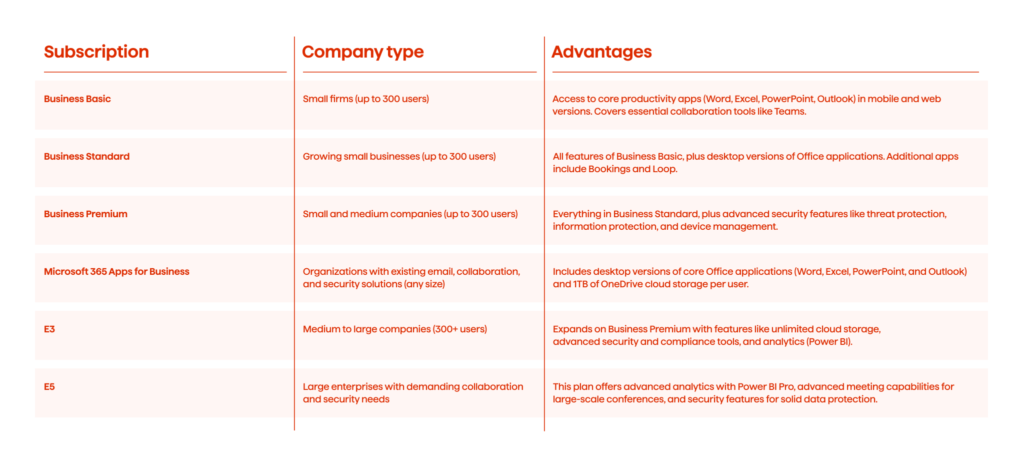How To Get the Most Out of Your Microsoft 365 Investment

May 9, 2025 5 min read
Squeeze every drop of value from your Microsoft 365 subscription.
More than 3.5 million companies worldwide use Microsoft 365. The digital workplace platform has established itself as the standard for location-independent communication and collaboration. Licenses are purchased on a per user per month basis and organizations can choose licenses suitable for their requirements.
Selecting the right Microsoft 365 licenses can be challenging. Factors include understanding the complex licensing options, and ensuring the chosen licenses align with the organization’s needs, and staying updated with frequent changes. Over or under-licensing can result in unnecessary costs or limited functionality. Additionally, low adoption by users can lead to lost efficiency in day-to-day activities. In this article, we’ll discuss key considerations to help you navigate the world of Microsoft 365 licensing and select the right options for your organization.
Microsoft 365 License and Cost Structure
Microsoft 365 offers a range of subscription plans. The subscriptions are designed to cater to various business needs and sizes. Each offers a different set of apps and services.
Business licenses are intended for small and medium-sized companies with up to 300 users. Enterprise licenses cover workplace productivity for larger organizations. Frontline licenses are lower-cost alternatives with apps and services for people in service and production. There are also various additional licenses for features in areas like security, audio conferencing, telephony, or workplace analytics. Some services have upgrade options with associated premium licenses (see table below).

Organizations choose from the licenses currently offered by Microsoft and then assign them to their users. It is possible to mix and match licenses. For example, larger enterprises may buy a combination of Enterprise licenses and security add-ons for specific users. As organizational needs change, IT can purchase additional licenses, reassign licenses to where they are needed, or end subscriptions to save costs.
Levers For Efficiency Optimization
Rightsizing Microsoft 365 Licenses
Rightsizing is a strategic approach to ensure that an organization only purchases the licenses it needs. It guarantees that the organization gets the most value from its investment while avoiding unnecessary expenses. It’s about purchasing the right licenses for the right people at the right time. This process involves understanding the specific requirements of each user group and aligning them with the appropriate Microsoft 365 license. It is crucial to conduct a thorough assessment of the organization’s needs. This includes understanding the roles and responsibilities of each user group, their software usage patterns, and their collaboration needs. For instance, users who only need access to basic Office applications may not require a premium plan that includes advanced analytics tools. Regular license audits can help identify unused or underutilized licenses, which can then be reallocated or decommissioned to optimize costs.
Eliminating Multiple Products Covering the Same Functionality
To fully utilize Microsoft 365 and reduce licensing costs, evaluate your digital workplace tools. Identify functionalities that overlap with Microsoft 365’s offerings. For instance, if you’re using a third-party video conferencing tool, consider migrating to Microsoft Teams. Similarly, if you’re using separate project management software, Microsoft Planner might suffice. By consolidating these tools into Microsoft 365, you can eliminate the need for third-party licenses, thereby reducing overall costs.
Learn how we created a custom, highly configurable intranet system with SharePoint that reaches a 99,9% uptime. Success story
Adoption and Change Management for Microsoft 365
By educating users on the capabilities of Microsoft 365 tools they already have access to, they can streamline their workflows, improve collaboration, and reduce redundancy. This not only enhances productivity but also maximizes the return on investment into Microsoft 365.
IT administrators can assess the current usage efficiency of Microsoft 365 in their organization using the following tools:
- Adoption Score: this tool provides a metric that reflects how well your organization is adopting Microsoft 365. It considers active usage of various services and compares it to the number of assigned licenses.
- Microsoft 365 Admin Center Reports: these reports offer insights into how your organization uses Microsoft 365 services. They can show the number of active users, which services are used most, and trends over time.
- Microsoft 365 Usage Analytics within Power BI: this feature creates a dashboard with a cross-product view of the last 12 months how users adopt and use Microsoft 365. In addition to pre-built reports, custom reports can be added. For example, there is a pre-built summary of adoption trends and a drill-down view into the volume of active users and the key activities for each product.
By regularly reviewing these metrics and reports, IT administrators can identify underutilized services, drive user training where needed, and ultimately optimize the usage of Microsoft 365 in their organization.
It’s crucial to provide ongoing training and support to guarantee users are up-to-date with the latest features and best practices. This proactive approach to digital literacy empowers them to leverage the full potential of Microsoft 365, thereby driving organizational success.
Conclusion
To minimize costs and maximize efficiency with Microsoft 365, organizations can strategically rightsize their Microsoft 365 licenses for the best fit of their people’s needs. Moreover, they can assess their digital workplace and transition services to Microsoft 365 where feasible, eliminating the need for third-party licenses.
User education on Microsoft 365’s capabilities and continuous training can enhance productivity and ensure maximum utilization of the platform. With Adoption Score, Microsoft 365 Admin Center reports, and Microsoft 365 usage analytics within Power BI, there are several tools available to make data-driven decisions.
Avenga can support you with our advisory for Microsoft 365 license selection and rightsizing, deliver Microsoft 365 migration projects, and provide resources for adoption and change management: contact us.



